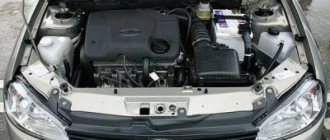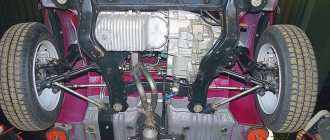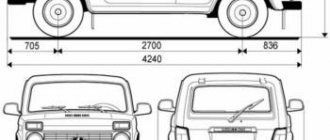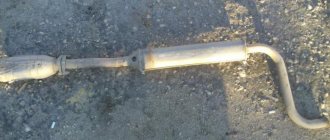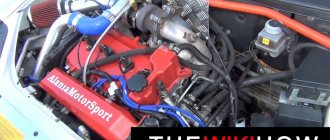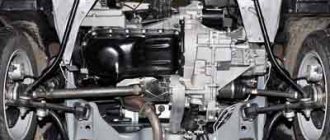The VAZ 11183 engine was designed for the Kalina car. The 21114 engine was taken as the basis, the engine markings changed (1 instead of 2 at the beginning of the internal combustion engine designation), the design of the crankshaft and cylinder head. Changes were necessary to increase the volume to 1.6 liters, and the use of existing parts was necessary to reduce the cost of the power drive.
ICE 11183
Technical data VAZ 11183 1.6
- VAZ 11183 1.6 is a four-stroke gasoline engine, the four cylinders of which are arranged in one row.
- Power supply of the power unit, injection, distributed fuel injection.
- The cylinder block of the Lada Kalina internal combustion engine is made of especially durable cast iron. The gas distribution mechanism is single shaft, has 8 valves. The timing mechanism is driven by a toothed belt from the crankshaft pulley.
- The engine piston has a stroke less than the cylinder diameter of 75.6 mm and 82 mm, respectively. The compression ratio of the internal combustion engine is 9.6. The fuel used is AI 95. It is permissible to use AI 92, for which you need to change the ignition timing.
- Power VAZ 11183 1.6, at 5200 rpm min., 81 l., sec. Torque at 3000 rpm, min., 125 Nm.
- Environmental compliance standards: Euro 2, Euro 3.
Fuel consumption
Fuel consumption when driving around the city is 8.8 liters per 100 km, mileage. When driving on the highway 6.2 liters. Total consumption is 7.6 liters per 100 km, mileage.
Oil consumption
The permissible consumption of motor lubricant is 50 grams per 1 thousand km. Types of oil used: 5W40, 10W40, 5W30, 15W40. The volume of engine lubricant in the VAZ 11183 1.6 engine is 3.5 liters. When changing, fill in 3.2 liters. Manufacturers recommend changing the oil every 15 thousand km.
Resource
Engine operating life according to factory data is 150 thousand km. In reality, in the right hands, the VAZ 11183 1.6 can last up to 300,000 kilometers.
Maintenance
According to some information, the change in the index is associated with a change in the supplier of the connecting rod and piston group; if in engine 21116 the supplier was Federal Mogul, then in the engine with index 11186 AvtoVAZ independently mastered the production of ShPG. In the previous catalytic collector with a cylindrical block, four channels coming from the engine converged almost to one point, the exhaust gas flows collided, creating additional backpressure.
General design features of internal combustion engines
The VAZ 11183 1.6 engine is a modified version of the already well-known carburetor power unit VAZ 21083. Most of the design elements are borrowed from this model. The cast iron cylinder block also has four in-line cylinders. But the aluminum cylinder head is adapted for distributed fuel injection. It has an overhead camshaft. The valves are driven by fists through pushers. Hydraulic compensators are not provided on this engine model. Because of this, periodic adjustment of the valves is required. Which you can do yourself by selecting the required number of steel washers.
The 11183 1.6 engine block is very similar to the VAZ 21083 power unit block. The only thing that has changed is the height of the cylinder block. As a result of these changes, the stroke of the piston group increased. It became 75.6 mm, instead of the previous 71 mm. Accordingly, engine capacity increased from 1.5 liters to 1.6 liters.
Modification 11183 (Standard package, 82 hp)
Engine 11183 (under the hood of Lada Kalina)
The very first modifications of the Grant car came with a non-lightweight connecting rod and piston group; on such engines the valves do not bend, it all depends on the speed at the moment the belt breaks. These engines were installed on cars in the “Standard” configuration and had the designation 11183. The advantage of this engine is its high-torque power; at the bottom it drives like a diesel engine!
In fact, this is a complete copy of the VAZ-2108 engine, only with an increased volume, and the owners of the nines boasted about stories about how the timing belt broke and nothing happened to the engine.
Design features of the VAZ 11183 timing belt
The camshaft of the gas distribution mechanism is driven from the crankshaft pulley using a toothed belt. Belt tension, unfortunately for drivers, is manual and brings a lot of trouble. Therefore, the belt often has to be tightened manually. A very important and pleasant point for owners of such an internal combustion engine is that when the timing belt breaks, the pistons do not meet the valves. This is possible thanks to the special design of the pistons, which has a recess in the upper part.
Which VAZ engine is better?
A large number of different engines are installed on cars of the Volzhsky plant. At first glance, it seems that they are all very similar to each other, but each of them has its own advantages and disadvantages, often associated with the simplicity of the design.
This is the youngest engine in the Lada engine line. It is practically not used in the Volzhsky plant’s own products at this point in time, with the exception of the remnants of old versions of the “Standard” configuration, but it still finds application in the products produced by the plant under the Datsun brand.
This engine is a logical continuation of the VAZ 21114 engine, which was previously used on the Samara-2 and VAZ 2110 families. The main difference from its predecessor was the increase in the compression ratio in the cylinder to approximately 9.6 units, this was achieved by changing the combustion chamber, which made it possible to lower the maximum torque bar torque from 3000 rpm to 2600, the peak value is 120N/m. Maximum power is achieved at rpm of 5200 and is a low 81 horsepower. The material of the cylinder block, like all other products of the VAZ engine division, is cast iron, which significantly increases its service life and subsequent maintainability. The regulated engine life is 150 thousand kilometers, but in practice, engines with a similar index often last more than 300 thousand with proper care and operation.
- Easy to repair and maintain;
- Due to the low compression ratio, it is possible to use cheaper fuel with an octane number of 92 units;
- In the event of a timing belt break or a cooling system pump stop, the valve group does not meet the piston group, which greatly simplifies subsequent repairs and financial costs
- Not a high transport tax, not crossing the 100 horsepower bar.
- Due to the use of an old type piston group, the engine is quite noisy and vibration-loaded;
- There are no hydraulic compensators, which requires adjustment of the valve group every 15 thousand kilometers;
- There is no automatic timing roller tensioner; periodic tightening is required to eliminate the problem of the belt slipping over the rollers.
Modifications of the internal combustion engine VAZ 11183 1.6
This engine underwent a major modernization in 2011. On the new model, the receiver has been enlarged, and the throttle valve has received an electronic control system. The type of throttle control is called E-gas. The new engine acquired its own VAZ 11183-50 index, and its power increased to 82 hp. What is also important is that the VAZ 11183-50 began to comply with European compliance standards Euro 4.
It should be noted that in parallel with the VAZ 11183 engine, the VAZ 21114 engine was produced. By and large, this is the same engine. Most systems, components and mechanisms are identical.
However there are some differences:
- in the power system of the VAZ 21114 engine they used a completely different generator 5132.3771 for 90 Amp hours;
- a new fastening method was used to mount the generator;
- To drive the generator, a new belt with a thickness of 882 millimeters was used. The mechanism for tensioning the belt has also been changed.
All other components, systems and mechanisms of the engine are completely the same, despite the fact that the motors were produced in different production shops.
Advantages
The VAZ 11183 engine with 8 valve injector has a fairly large number of positive qualities with which many associate its popularity. Owners of cars with this engine note the following advantages:
- The safety margin of the main elements is reserved by the factory. This leads to the fact that the engine, with the right approach, lends itself well to tuning. At the same time, increasing power to 130-150 horsepower does not affect its service life in any way.
- Many people say that the motor has received a much longer resource in comparison with its brothers. This is a completely justified statement, since it began to be assembled with improved quality components, so with the right approach it can go much further.
- The motor is very unpretentious in operation. Many people pay special attention to the lubrication system, since the quality of the oil is practically unimportant, since there are no hydraulic compensators in the design. Of course, you should follow the manufacturer's recommendations.
- Unpretentiousness to fuel. The compression ratio was increased, but to reasonable limits, and the power system was designed in such a way that the engine copes well with low octane gasoline. This is an excellent solution, given the quality of domestic gasoline.
- Timing belt The main advantage of using an 8-valve mechanism is that if the belt breaks, there is no contact between the pistons and the valves. Therefore, you should not be afraid that unplanned repairs may be required.
Recommendations for servicing the Lada Kalina engine
The service life of any engine depends on proper maintenance from the very first days of operation; the VAZ 11183 1.6 engine is no exception to the rule.
The manufacturer recommends servicing this engine in the following order:
- During the first kilometers of driving, the entire car undergoes grinding in of parts, including the engine. The grinding-in period is called the running-in period. It lasts about 1.5 thousand kilometers. After it expires, you need to replace the engine lubricant and the oil filter element.
- The next stage of maintenance must be performed after a mileage of 10 thousand kilometers. The engine oil and oil filter must be replaced. Also, at this stage it is necessary to change the air filter, measure the compression in the cylinders and adjust the valves.
- After 20,000 kilometers, it is necessary to diagnose all mechanisms and systems of the internal combustion engine. Naturally, you need to change the engine oil, since it must be replaced every next 10,000 kilometers.
- After 30 thousand, you only need to change the engine lubricant and filter element
- After a mileage of 40 thousand km, many engine elements and parts must be replaced:
- replacing the air flow filter element;
- replacing the fuel filter element;
- replacing the timing belt and roller;
- replacing the alternator belt if necessary;
- replacing the pump at the slightest play in the fuel pump pulley;
- replacing the valve cover gasket;
- other parts requiring replacement;
- In addition to replacing parts, during this period of operation the valves should be adjusted and diagnostics of the internal combustion engine systems should be carried out.
Subsequent maintenance must be carried out in accordance with points 2 and 5. The exception is motor oil and filter. They need to be replaced every 10 thousand kilometers.
Oil change video
Advantages and disadvantages
The advantage of the 11183 engine is the cylinder head of the original design. However, it was subsequently further modified into the ICE 11186, adding volume to the combustion chambers. The downside is the generator belt tensioner - the drive is constantly over-tightened, a deflection of 10 mm is not ensured without slipping, so the belt life is reduced and it has to be changed more often. This defect was corrected only in the next version of the motor 11186.
The integrated catalytic collector assembly in the engine was initially unfinished:
- the tubes of the four channels are short;
- flows converge inside the block at almost one point;
- exhausts collide and create opposition to each other;
- the shape of the block did not allow changing the arrangement of the tubes.
Catcollector 11183
When installing the engine on the Lada Granta, the cabin heat exchanger was connected to the thermostat in series. All the coolant passed through it along a small circuit, the response temperature error was 5 degrees instead of the required 2 degrees.
Possible malfunctions of VAZ 11183 1.6
The VAZ 11183 engine is an improved version of the VAZ 21083. Most of the possible malfunctions for these engines are similar:
Flow sensor
For cars, a number of VAZ models, including Lada Kalina and Lada Granta, stopping the engine while driving is popular. Experienced drivers know that the culprit of the breakdown is the sensor responsible for mass fuel consumption. When replacing this sensor, the engine will start without problems.
Oil leaking
A popular problem is engine lubricant leaks. Oil can leak through the valve cover gasket, gaskets and seals. Sometimes a leak can be so critical that complex repairs cannot be avoided. Critical failures include oil leakage through the crankshaft seals.
Overheat
Overheating of the VAZ 11183 power unit occurs due to the thermostat. Unfortunately, the quality of domestic spare parts leaves much to be desired. A newly installed thermostat may not work. The motor may overheat, or on the contrary, it may not heat up.
Engine knock
Knocks in the power unit are a real problem for many VAZ cars. It is necessary to take into account the fact that the engine knocks when cold. If the engine has already warmed up and the valve clearances have been adjusted, the problem may be more serious. To determine the problem, you will need to diagnose the internal combustion engine.
ECU
The control electronics on the VAZ 11183 1.6 engine is one of the sore spots. Most drivers have encountered its replacement. There may be several reasons for this. For example: increased fuel consumption, the engine cannot develop full power, idle speed failure.
Engine tripping
If the engine starts to stall, you need to check the spark plugs. If the spark plugs are OK, then the ignition coil has failed. Very rarely a valve can burn out.
The revolutions are floating
If the engine speed fluctuates, then with a high probability it can be said that a dirty throttle valve is to blame. Often the cause may be a failed electronic sensor.
Crankshaft bearings
If, when accelerating, you can hear the sound of metal in the engine, then there is a high probability that the crankshaft liners are rattling. Further operation of the vehicle is not advisable until the problem is resolved. Otherwise, scuffs may form on the crankshaft journals.
As can be seen from everything described above, the VAZ 11183 power unit has many weak points and possible malfunctions. However, given the simplicity of the engine design, drivers fix most internal combustion engine problems themselves. Here, it must be said that spare parts for the VAZ 11183 are low in cost. Thanks to these circumstances, many domestic drivers fell in love with this engine. They consider it a reliable, easily repaired power unit.
Malfunctions: causes, elimination
If the timing belt of the drive breaks, the 11183 motor does not bend the valve, but it has the following typical breakdowns:
| Floating speed | 1) malfunction of the ignition module 2) gasket breakdown 3) valve burnout 4) failure of the TPS sensor | 1) module replacement 2) installing a new gasket 3) valve replacement 4) repair or replacement of the throttle position sensor |
| Extraneous noise | 1) misadjustment of valve clearances 2) piston wear 3)bearing wear 4) production of liners | 1)adjustment with valve gaskets 2) replacement of pistons, rings 3)replacement of bearings 4) use of new liners |
| Alternator belt break | excessive tension, manufacturing defect | Regular check, replacement as necessary |
Since a feature of the ICE 11183 is a well-thought-out design of valves and pistons, overhauls in most cases are carried out on time without additional user investment.
TPS sensor for 11183
Speed and savings. Who will win
The long service life of the cylinder block, as well as the well-established production of parts with repair dimensions provided for in accordance with the repair and design documentation, make it possible to repair internal combustion engines and extend the life of vehicles. If engine production volumes increase, then it would be reasonable to purchase additional equipment and organize the production of connecting rod and piston group parts in Togliatti.
Engine tuning 11183
Tuning the 11183 engine is quite simple and even an inexperienced car enthusiast can do it. So, the first thing motorists do is chip tuning. This is a procedure for “pumping” the car’s on-board computer for the following purposes:
The process of disassembling the block head.
- Reducing fuel consumption.
- Increased power characteristics.
- Balanced. This is when there is a balance between fuel consumption and power.
The next stage in which the engine is being finalized is replacing the mechanics. This category of tuning includes changing the piston group to a lighter one, installing an improved gas distribution mechanism, replacing a high-power water pump and silicone cooling pipes, as well as using a more improved injection system. All this allows you to increase engine power by 30 hp.
The last stage of tuning is the modification of the engine. This stage includes installing a “zero” resistance filter, replacing and setting the ignition system to early, as well as optimizing the operation of the electronics.

